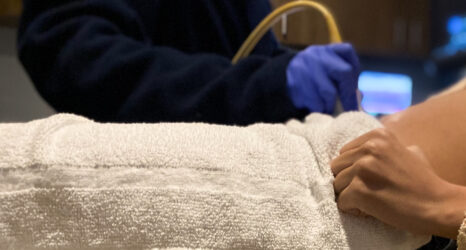Right after I wrote a story about photos my grandpa had taken in the 1950s of a woman’s uterus after a botched abortion, I started working on a painting. I am what some might call a “hobby” painter. I was one of those teenagers who spent a majority of high school in the art room, but promptly put my brushes away at the beginning of college. I returned to painting two or three years ago after a 20-year hiatus and 10 years of broken promises to myself to revisit my creative side. Returning to the art room after so many years brought me back to a mindset that had long been buried. I had forgotten how freeing painting could be and how my subconscious would work itself out on the canvas.
On this particular day, I was more or less experimenting with textures and didn’t have a specific direction. Fascinated by the texture, I grabbed a roll of drywall tape and affixed it to the canvas. That was all I had. I stared at the blank, albeit textured, canvas stumped. Going to the bookshelf for inspiration, I happened upon a photographic image of a naked women sitting on bench, or perhaps an exam table. There was something about her that drew me in. It was as if I was meant to find her while skimming through shelves of books. Already she felt a part of my painting.
Her body easily formed upon the canvas. Instead of being too controlled in my strokes, I allowed myself to just let go. Then I started working on her mouth. For the first time, I became frustrated. Every line just looked wrong. I painted and repainted her mouth. I had to step away.
When I returned to my canvas, I realized that it looked as if the woman had her mouth taped. It was as if her voice was taken away. It felt right in such a wrong way. After spending so much time thinking about abortion and my grandfather and all the struggles women have faced in the past, somehow I knew this was my own personal response. This woman sitting naked on a examination bench, was already defeated. She was naked and in charge of her body in one way, yet her voice was being silenced. Without a voice, we are sentenced to a life with no choice. Much like my grandfather’s own sentiments, I looked at the woman in my painting and felt a pang. Women should not ever have to be silenced again or be stripped of choice.
I truly believe the painting grew from an internal fear that possibility of choice could be yanked away in my lifetime for my friends, my daughter and for women around our country. Fear shouldn’t exist to receive medical care, yet it does. The chasm between pro-choice and anti-abortion supporters continues to widen, threatening women’s access to the proper medical care they deserve.
Yet, I also see hope in the image. There exists the opportunity for her, and all women, to free her voice and protect the one thing that belongs solely to her: her body. She must stand up and let her voice be heard.





